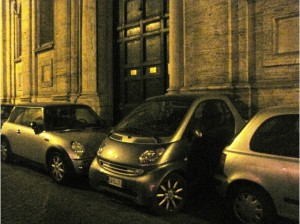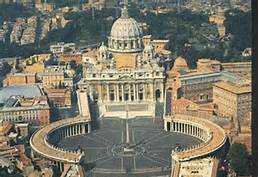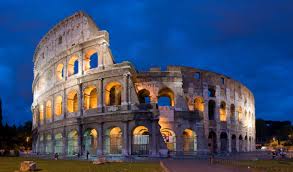Here are three things you can expect from the Synod – Rome is a colorful place, to say the least, and it has certainly left its stamp on the Vatican.
- Chaos. The Vatican is not Italian. It’s Roman. Do not try to impose your standards on it. You want Romans to be in charge of things like food, fashion, all things epicurean and aesthetic. They do bureaucracy well if you think bureaucracy is a good thing in the first place, hence a Vatican that almost everyone acknowledges needs to be reformed/re-orged/rebooted/re-everything. Look at this. This is how Romans park their cars.

Actually, this picture doesn’t do them justice. It’s a little too organized. But still, note the directions of the cars. I love Rome and Romans; if you know them, you understand the Vatican better and you don’t allow yourself to be uber American and maniacal about media. Instead, you do as the Romans. You know, when in Rome, and all that… You ignore the chaos and go about your life, you use the chaos to your advantage either to create more chaos, or to get away with something, or you sit back and enjoy the entertainment. Take your pick. Why do you think Pope Francis arranged for two consecutive Synods on the family (and perhaps even a pre-Synod of sorts)? It takes time to sift through chaos. - Ambiguity. Again. This. Is. Rome. This. Is. The. Vatican. #ThisIsTheUniversalChurch. You really think this is easy? Sometimes we barely agree on the articles of the Creed. Give everyone a little space to work things out and wrap their heads around things. Let them get over personal, geographical, political, and every other kind of difference so that they can see what they have in common. The great thing is that all of this chaos is making clear exactly what work needs to be done. St. John Paul II’s Familiaris Consortio was largely ignored; so now things are even more of a mess than they were when he wrote it in 1981, after the 1980 Synod on the family. To change that, there’s going to have to be a lot of clear teaching. It’s everyone’s job, not just those who speak from the pulpit. St. John Paul II spoke of the “mission” that we all have to the family. Instead, way too many people ignored him or went back to sleep.
So now we’re back facing the tired arguments of the 70s as if the 1980 Synod on the family and Familiaris Consortio never happened. Start teaching. If you don’t like what the Catholic Church teaches, well, be honest. Decide whether you can work your mind around what she teaches or whether you can accept it without understanding it. If you can’t, then in good conscience, you really should find something that fits more with your beliefs. But, first, check out what the Catechism has to say about conscience and the “work” of forming one’s conscience. It really is work. It’s difficult. Part of that work is taking place now at the Synod. It’s messy. That’s normal.
- No change in doctrine.The Church cannot change her doctrine. A recent example (recent in terms of a 2,000 year old entity), is contraception. Pope Paul VI formed a commission to study the question of whether contraception could be consistent with Catholic teaching. It hadn’t been so far, but maybe something had been missed. The majority of the commission voted to approve birth control. Guess what. Despite majority opinion, Church teaching did not change. In fact, the confusion ensuing from Humanae Vitae proved fruitful in many ways. It demonstrated that there was a clear lack of teaching/understanding. After all, if the pre-Vatican II Church had been so strong, how could the sexual revolution have happened? Catholics as a whole had been experiencing a crisis of faith. Councils don’t get called except to address a crisis. There was no 1950s golden age of Catholic faith. Had there been, I maintain that the response to Humanae Vitae would have been very different and Catholics would have been a strong and beautiful witness that may have even kept the sexual revolution from happening with the quasi sexual intensity that it did. But the confusion paved the way for St. John Paul II’s theology of the body, a much needed presentation of the beauty of sex, marriage, and the family. I’ve also commented that Cardinal Kasper’s remarks have also borne fruit that we needed, albeit perhaps unintended by him. I’m convinced that more good will come. We just need to be patient about the process even if we don’t like it.
So what can you do in the meantime? Here are some suggestions –
- Have a drink, if that’s your thing.
- Go for a run.
- Spend some quality time with family, friends, etc.
- Listen to music.
- Wash your hair.
- Organize your sock drawer.
- Count the blades of grass in your yard.
- Read Familiaris Consortio.
- Read Humanae Vitae. (C’mon, it’s a short document. The Vatican English translation is arguably better than the Pauline edition.)
- Have an opinion on marriage prep or annulments? Find out what you really know. Ask about your diocesan or parish marriage prep program. Read the annulment paperwork on the marriage tribunal’s page of your diocesan website. If they don’t have it posted, call and ask.
- Read something to enrich your understanding.
- Spend time in quiet contemplative prayers and let yourself hear God speaking to you.
- Let the Holy Spirit do its work.
Yes, there’s chaos, but this too shall pass. Ignore the alarmists. Anyone who disrupts a Christ-centered peace is doing someone else’s work, not Christ’s. Read Church history. We have always been a rather muddled mess. That’s what proves the Church is divinely instituted. No merely human institution could withstand humanity and all its foibles as long as the Church has.

St. Peter’s, with the dome reaching towards heaven and the arms (braccie) of the piazza embracing and drawing together humanity.

